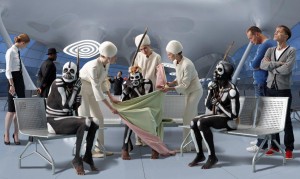 For that reason if AES+F s previous work, The Feast of Trimalchio, can be seen as frozen pornography, then Allegoria Sacra is lethargic eschatology. Culture and civilisation in a coma — this is the artists’ basic theme.
For that reason if AES+F s previous work, The Feast of Trimalchio, can be seen as frozen pornography, then Allegoria Sacra is lethargic eschatology. Culture and civilisation in a coma — this is the artists’ basic theme.
Continuing the most superficial comparison of the new work with The Feast ofTrimalchio we note that Allegoria Sacra is a statement in the first person plural, Zamyatin’s ‘we’. The narrative takes place in the present and prevents the viewer from distancing themselves from the action in order to be confident of their own non-participation and security. The Feast of Trimalchio was a tale of an external event, of something which takes place somewhere else and without us. We remained observers and retained the right to say ‘We are different. We laugh at those who we are not and we have no connection to them’. The visual arrav of Allegoria Sacra can be seen not only as an apocalyptic version of one of the sacred stories but at the same time, and above all, as a live broadcast of events, like a survey of an internal space as seen by security cameras. The viewer is simultaneously in several spaces and within several stories. And it is precisely this situation which returns the viewer (us) to a here-and-now-experience, to taking a decision at the threshold of a world where there are no borders or crossings but only a waiting room.
The people who are waiting for flights belong to various cultures, traditions, languages and books. They glance in to the empty sky or seek out some timetable or another. The ruins of meanings with which the artists work are taken from various cultural complexes of the past — the Middle Ages, the Renaissance with its reading of antiquity, the Baroque. They make sounds, speak and throw out cues which both confirm and contradict each other. The sequence of events does not reflect the genuine content of history and the incident-filled picture does not represent reality. Reality can be found behind the forms, on the other side of those forms which recreate contemporary culture. These characters, who died or never lived, continue to act outside reality, as if denying, not noticing, or ignoring it.
The first frames of the video read like a prologue and in this way recall Goethe’s ‘Ye wavering shapes, again ye do enfold me’ and the ‘Prologue in Heaven’ of ‘Faust’. It is simultaneously a tribute to medieval comedy. Once more Mephistopheles is heard:


